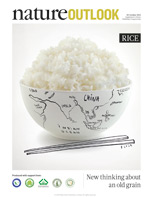Nature Outlook: Rice
Nature Vol. 514 No.7524 ppS50–66, 30 October 2014

Rice is not just another grain. For three billion people, it is a daily necessity (page S50). Since its domestication some 8,000 years ago (S58), rice has played a part in building civilizations, shaping societies and, most of all, feeding a growing world.
But the climate is changing, and much of the land that once went to paddies is being consumed by expanding cities. There is a realization that farmers cannot keep applying fertilizers and pesticides to their crops without environmental consequences. If rice is going to feed future populations — in Asia, Africa (S64) and beyond — scientists will have to help to improve yields.
Rice research involves scientists around the world. This year marked a milestone achievement: the publication of the genomes of 3,000 strains of rice will help to guide the creation of hardier, more productive crops (S60). Researchers are addressing a massive nutritional crisis by converting rice into a vehicle for vitamin A, but a combination of technical challenges and public opposition threatens the development of this ‘golden’ rice (S55). Scientists plan to retool the way in which rice harvests energy from the Sun (S52) and are tackling problems such as arsenic contamination (S62).
Many questions remain, but the biggest — will there be enough rice? — will take decades to decide. Governments and scientists can use that time to work together on the answer (S66).
We are pleased to acknowledge the financial support of the Institute of Genetics and Developmental Biology, Chinese Academy of Sciences (CAS); the Institute of Plant Physiology & Ecology, Shanghai Institutes for Biological Sciences, CAS; the Institute of Botany, CAS; the Institute of Crop Science, Chinese Academy of Agricultural Sciences (CAAS); and the China National Rice Research Institute, CAAS, in producing this Outlook. As always, Nature has sole responsibility for all editorial content.

